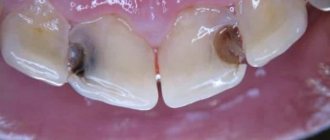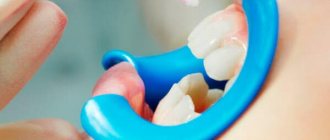Symptoms
Visiting the dentist and getting dental treatment is accompanied by unpleasant sensations and discomfort. Pain can and should be present after therapeutic measures. But it goes away after a short period of time.
If pain persists, then under no circumstances should it be ignored. They will lead to the development of inflammatory processes. The result is a damaged tooth.
Signs of an incorrectly installed seal include:
- Inability to clench or clench teeth. It feels like the filling is too high and protrudes above all the teeth. Therefore, when chewing or moving the jaw, there is a feeling of a foreign object in the mouth.
- A feeling of pain that intensifies when chewing. It occurs due to both over- and under-inflated fillings.
- Sharp or overhanging edges. The filling may have a tight fit to the bite, but at the same time cause injury to the gums or tongue. These injuries can lead to the development of stomatitis.
- Permanent injury to the papilla. This is caused by incorrect actions of the dentist, who did not preserve the interdental gaps during treatment. As a result, it becomes difficult to brush your teeth and your gums begin to bleed.
The norm is the presence of discomfort and pain in the first 3-4 days after dental treatment. Everything should go away on its own after this period. But if the discomfort persists, then you should immediately contact your dentist so that he can eliminate this problem. Most often this takes a few minutes and does not require additional intervention.
Possible consequences
An incorrectly installed seal can lead to a variety of unpleasant consequences:
- When the position of the filling is too high, a high load is placed on the tooth: when closing the mouth, the teeth of the jaw located opposite it exert excessive pressure on it. Chronic injury occurs. Regular pressure can provoke the formation of pulpitis and periodontitis. As a result of this process, the injured tooth is subject to depulpation.
- If there is pressure on a filled tooth, there is a high risk of chip damage, including surface chipping.
- If, when closing the mouth, the teeth close on one side, but not on the other, then there is a misalignment that can contribute to dislocation.
Pulpitis and periodontitis Chip Dislocation of the jaw
Incorrect positioning of the jaw during teeth closure and blocking lateral displacements can provoke pathology of the temporomandibular joints. Pain, crunching, clicking in the articular tissue of the lower jaw are symptoms of the disease described above, the cause of which is overestimation of the filling.
We suggest you read What to do with flux on the gum of a baby tooth: causes and treatment in children of different ages
Causes of an incorrectly installed seal
After treating a tooth, the dentist must install a filling that will protect and isolate sensitive tissues from bacteria and microbes entering the resulting cavity.
The filling material undergoes a polymerization process and then must be properly sanded. At this stage, the doctor monitors and corrects its fit to the tooth, as well as its position relative to the gums, cheeks, and tongue.
The most common causes of toothache after a filling is installed are:
- Oversized filling.
- The solution has shrunk.
- The treatment procedure was carried out in violation.
- Inflammatory began in the canals.
- Poor quality filling material.
- Allergy.
- Incorrect diagnosis and, accordingly, treatment.
- There was an infection in the dental canals.
On this topic
- Seals
Let's find out why a tooth hurts after a temporary filling
- Maria Konstantinovna Tevs
- October 5, 2020
To control the protruding edges of the filling material, its position relative to the rest of the teeth and the bite, the dentist uses a special coloring strip. The test is that the patient must bite it several times. If the doctor sees that there are no obstacles, then he begins polishing.
This is a very important stage, because if you make a mistake and do not notice the protruding edges of the filling, they will cause problems with chewing food and oral hygiene, which will lead to the development of negative consequences and various diseases.
Description of the problem
After installing the filling, the dentist grinds it according to the bite: he asks the patient to bite on a piece of copy paper and asks whether the placed filling is in the way, corrects it in accordance with the patient’s wishes, and polishes the material.
If during this stage the doctor makes a mistake, it will feel like a foreign body on the tooth and bring discomfort to life. Often the client does not immediately detect the problem. While anesthesia is in effect and numbness is present, it can be difficult for the patient to determine whether the placed filling creates interference.
Some people in such situations mistakenly believe that over time its surface will wear off on its own. Experienced dentists do not recommend waiting for this moment, because modern materials used in fillings are durable and resistant. It takes years to wear out an extra millimeter of material.
Even an old filling can cause discomfort for a long time
It is not advisable to get used to discomfort, since an overestimated tooth position provokes not only unpleasant sensations, but also more serious consequences.
What to do
There are several ways that a new filling can cause discomfort. Among them:
- Wrong size. It may be too big or small for the tooth.
- Poorly installed and polished filling. The filling material protrudes from one side of the tooth, causing additional discomfort.
Any of these problems can lead to further tooth decay. It is better not to try to correct the situation on your own, but if you notice the first symptoms, immediately contact your dentist.
The doctor must properly sand the filling material. The adjustment will take a maximum of 5-10 minutes.
Some people are in no hurry to seek help from a specialist because they mistakenly believe that the filling itself will wear off over time and stop causing discomfort. But the modern material that dentists use is more durable. A high-quality filling will shrink and begin to wear off only after a few years.
In what cases are fillings installed?
Filling material is used for:
- Treatment of pulpitis and periodontitis.
The pulpitis therapy procedure is carried out in several sessions. It involves removing nerve endings from the root canals and replacing them with a special filling material. During the first procedure, arsenic paste is first applied to the chewing three and four root teeth.
After thoroughly cleaning the canals, they are filled with a special filling material and sealed with gutta-percha pins. To assess the control of the work done, the dentist sends the patient for a repeat x-ray. After the specialist is convinced of the quality of his manipulations, the tooth cavity is closed with a temporary filling. The procedure for installing permanent material is carried out at the next visit.
Treatment of periodontitis in most cases is long-term. Root canals are not filled as long as there is an inflammatory process in them. The tooth cavity is constantly open. The patient performs antiseptic rinses at home. After the dentist is convinced that there is no inflammation, medicinal materials are placed into the dental cavity, and it is closed with a temporary filling.
- Treatment of caries. The procedure is carried out during one session. It consists of removing pathological tissues, carrying out antiseptic treatment, and forming new tooth tissues using filling materials;
- Carrying out restoration work aimed at improving aesthetic and practical qualities. Composites are installed for: pathological tissue abrasion, tooth chipping after injury, wedge-shaped defects, fluorosis.
We suggest you read: Is it possible to do ultrasonic teeth cleaning for pregnant women - professional cleaning during pregnancy and hygienic cleaning during pregnancy
If necessary, during therapy, the dentist uses local anesthesia. Modern anesthetics have good analgesic properties and have a small number of contraindications and side effects. After the injection, part of the patient’s jaw becomes completely numb and pain is not felt. After installing the filling, the doctor checks how well it matches the bite. This can be checked using a special carbon copy.
The specialist places a copy sheet in the oral cavity at the place where the filling material is installed and asks you to bite it and move it slightly with your jaws from side to side. After the carbon paper is removed, places on the filling that need to be sanded are visible.
It often happens that after installing a permanent composite, a person cannot adequately judge his occlusal comfort due to the effect of anesthesia. After it ends, the patient begins to feel discomfort.
In this case, you should not wait for a long time for the material to shrink or wear off. There is no need to try to get used to the inconvenience. Just go to an appointment with the dentist who performed the treatment. In most cases, there is no point in taking a visit pass. All you have to do is approach a specialist and explain your situation. The filling polishing procedure is completely painless, takes only a couple of minutes, and is free.
Doctor's actions
The dentist must act and take measures based on the reasons that led to discomfort after dental treatment. There may be several situations:
- The discomfort does not go away within several days. You should definitely visit a doctor who will polish the filling in a couple of minutes. Otherwise, negative consequences may begin to develop and tooth decay may occur.
- If the edges of the filling are too sharp, they can cause injury to the gums, tongue or cheek. In this case, you should immediately visit the dentist so that he can immediately polish the filling, thereby preventing possible injuries.
- A crack remains between the filling and the surface of the tooth. You should definitely see a doctor again, as bacteria and microbes will get into the gap that has formed, which will trigger the development of caries.
Also, do not ask the doctor to file down the filling too much. The teeth of the upper and lower jaws must be in close contact with each other while chewing food. If this does not happen, then the person’s bite will be disrupted.
Home treatment methods
As mentioned above, it is impossible to get rid of the problem at home, and it is unreasonable to expect natural abrasion of the material.
We invite you to familiarize yourself with Veneers or restoration - which is better?
To alleviate the condition before visiting a specialist, you need to follow certain recommendations:
- Avoid eating hard foods that require biting. The sealed unit, due to its higher location, is subject to the main load, and this is fraught with a fracture of its base.
- Eliminate hot foods from your diet. This is because such foods and drinks can cause swelling of the soft tissues, increasing the discomfort.
- For severe pain, analgesics or non-steroidal anti-inflammatory drugs can be used. However, you should not abuse such drugs, because their use is limited - no more than 5 days.
Silicate, silicophosphate cements
Materials from this group have been used by dentists for a very long time. Silicone cements have a bright white color, do not hold well, are rough to the touch even after polishing, and when placing such a filling you will feel a sour taste in your mouth. But! “Sourness” also happens when installing an expensive filling, if the doctor used silicate cement for laying under the filling.
Pros: such fillings are low-toxic, which is very good if you are treating a child’s teeth + low price (in some clinics they fill with silicate cement for free!).
Please note: the filling material of this group is prepared by mixing powder and liquid.
- Epigalin No. 60









